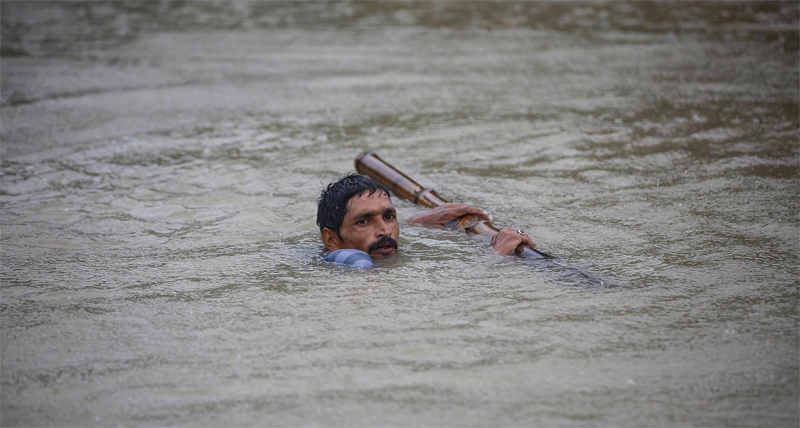
OR
DISASTER COMMUNICATION

After the 2008 Koshi floods we saw flood victims burn donated clothes to use them as cooking fuel.
Issues related to Disaster Risk Reduction (DRR), Disaster Management, information management, proper rescue and relief got a lot of space in disasters related forums after the devastating earthquakes of 2015. Both the government and NGOs advocated various DRR plans and policies. Two years after the tragedy, we should have learned a lot. But we clearly have not.
Consider the recent floods in Tarai-Madhes. Almost half the country has been inundated by floods. As of this writing, over 90 people are reportedly dead, hundreds are missing and thousands have been rendered homeless by the floods that followed three days of heavy rains. Southern part of our country is always prone to floods—flooding is the main natural disaster for Nepal.
It is possible to save many lives and properties through proper management of flood alert-related information. In this age of high-end information and communication, we again failed to establish proper communication immediately after the disaster. Electric lines were broken, telecommunication was disrupted and we lacked alternative communication systems.
Collection and dissemination of right information is vital. The focus of the government is currently on rescue and relief but the importance of effective communication must not be ignored, both during and after the disaster.
It is necessary to disseminate the right information on various diseases to prevent epidemics in a post-disaster scenario.
Commendably, various youth organizations, NGOs and civil society members have voluntarily launched campaigns to collect relief materials—in both cash and kind—to support flood victims. These initiatives are being replicated across the country. But vital information regarding relief collection seems to be missing. For example, we may be collecting old clothes that the victims might not use. We need to first gather information regarding what kind of relief materials are needed the most and where.
Proper collaboration and communication is lacking among NGOs, government bodies and other stakeholders working on rescue and relief, causing duplication and also creating space for fraud.
The biggest communication gap in previous disasters was regarding the needs of women and children. Even this time, few organizations or groups seem to be collecting sanitary pads for women and nutritious food for children. This is one example of how vulnerable sections of the society can be ignored during a disaster.
Besides, it takes many days to transport goods during such times. By the time relief materials reach the victims, they could have managed things for themselves. After the 2008 Koshi floods, we saw flood victims use donated clothes as fuel to cook meal. Others rejected such clothes out of anger as that was not what they needed at the time. All this was a result of communication gap.
Communications is not limited to passing information. It is more about sharing warning, giving instruction, generating ideas and building knowledge. Communication is critically important in all phases of disaster management—during preparedness, at the time of disaster and afterwards.
Satellite communication and GPS based communication system have been effective in big disasters like typhoons and tsunamis. But such systems can be reliably used only when local authorities, humanitarian organizations and people are well-prepared. Technology can be a savior, but only if used properly.
It is the government’s responsibility to help the people affected by disasters. But in countries like Nepal where the government is weak and under-resourced, it is vital that other humanitarian organizations, NGOs and youth groups also play their part.
Government and non-government actors often stand at opposite poles during disasters, as also seems to be happening right now. NGOs in Nepal have traditionally filled the gap created by government absence. So there is no reason why they cannot work together. But even for this it is vital that the right information is made available at the right time to the right people involved in relief and rescue operations.
The author is a political science graduate
saugat.gautam@gmai.com
You May Like This

Search for missing Israeli in Nepal continues
POKHARA, Oct 23: Police team, locals and the Israeli rescuers here are continuing to search for missing Israeli tourist Amit... Read More...

Man goes missing in flooded Kamala River found dead
LAHAN, July 26: Manoj Yogi of Bardibas, Mahottari who was swept away by the flooded Kamala River has been found... Read More...











Just In
- Japanese envoy calls on Minister Bhattarai, discusses further enhancing exchange through education between Japan and Nepal
- Heavy rainfall likely in Bagmati and Sudurpaschim provinces
- Bangladesh protest leaders taken from hospital by police
- Challenges Confronting the New Coalition
- NRB introduces cautiously flexible measures to address ongoing slowdown in various economic sectors
- Forced Covid-19 cremations: is it too late for redemption?
- NRB to provide collateral-free loans to foreign employment seekers
- NEB to publish Grade 12 results next week








Leave A Comment